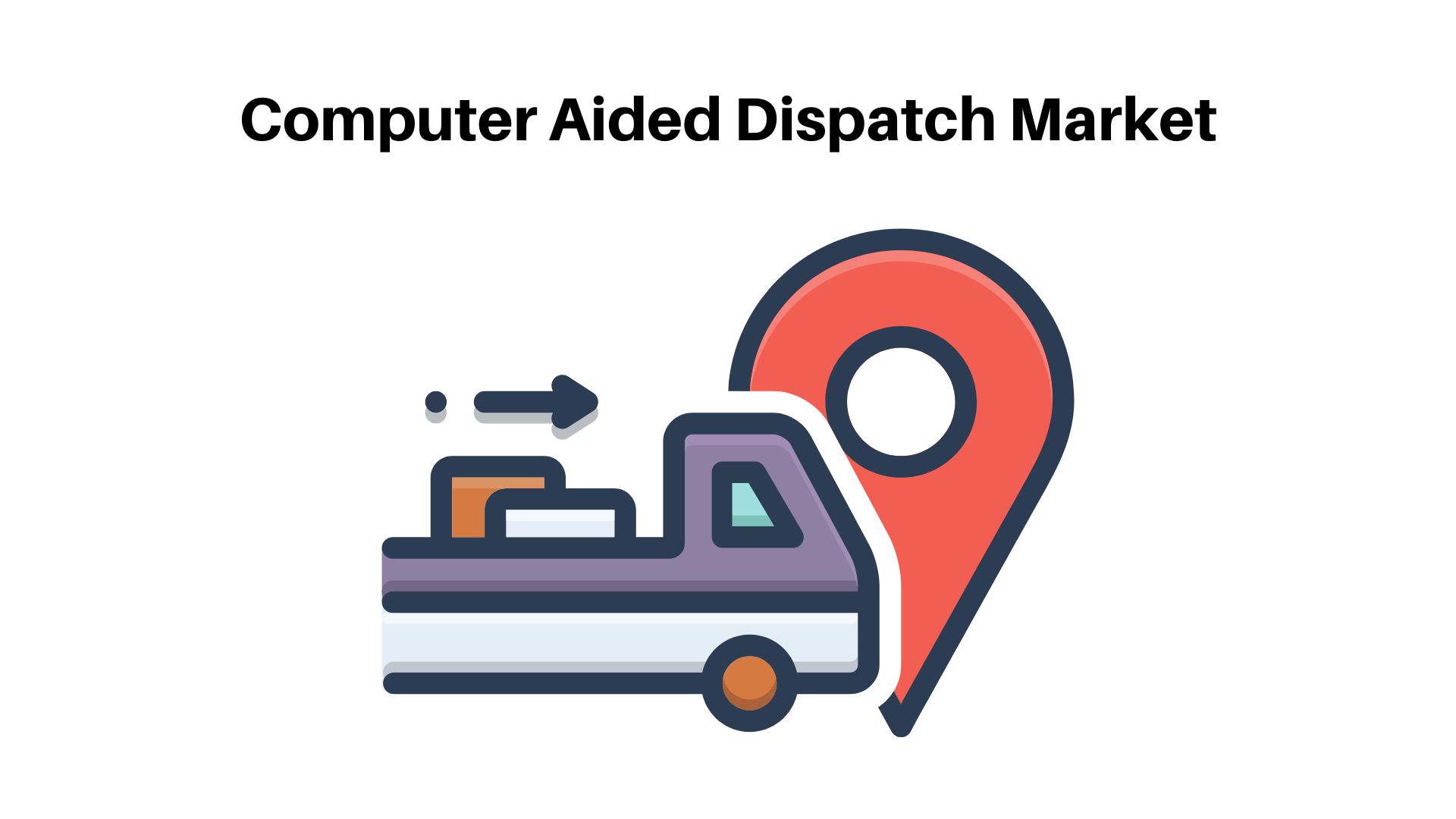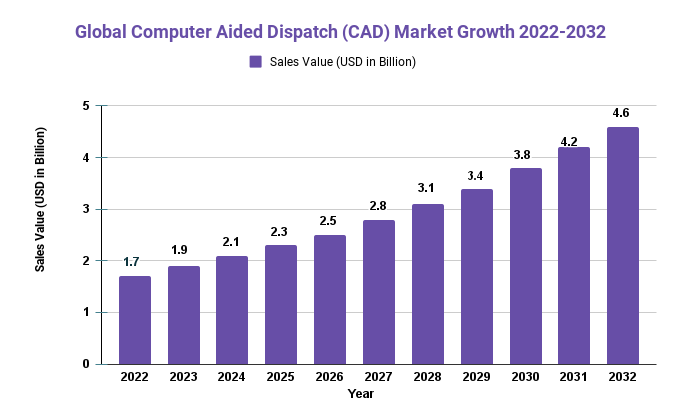Computer Aided Dispatch (CAD) Market Size USD 4.6 Bn by 2032| at a CAGR 10.5%

Page Contents
Market Overview
Published Via 11Press: The Computer Aided Dispatch Market is experiencing rapid growth due to an increasing need for effective public safety solutions. CAD systems are utilized by law enforcement agencies, fire departments, emergency medical services providers, and other public safety organizations to manage emergency response operations.
In 2022, the global CAD market was valued at USD 1.7 billion and is projected to reach USD 4.6 billion by 2032, rising at a compound annual growth rate (CAGR) of 10.5% during this forecast period.
The Computer Aided Dispatch Market is segmented based on component, deployment mode, application, industry vertical, and region. Software and services make up the bulk of this sector while deployment mode consists of cloud-based or on-premise deployment options. Application wise there are law enforcement, fire, and EMS applications as well as others while industry verticals cover government/defense, healthcare/life sciences firms among others.
North America is expected to hold the largest share of the global CAD market due to its high adoption rate for CAD solutions in this region. On the other hand, Asia Pacific is projected to experience the highest compound annual growth rate during this forecast period due to increasing demand for public safety solutions in countries like China, India, and Japan.

Drivers, trends, and challenges have an impact on market dynamics, which can impact businesses. Request for PDF sample report
Key Takeaways
- The CAD market is expanding at an impressive rate due to the rising need for effective public safety solutions.
- The market can be broken down into components, deployment mode, application, industry vertical, and region.
- North America currently holds the majority of the global CAD market, while Asia Pacific is expected to experience the highest compound annual growth rate throughout the forecast period.
Regional Snapshot
- North America: The North American CAD market is expected to dominate the global CAD market due to the high adoption rate of CAD solutions in this region. The United States leads this region due to the presence of several key players and the growing demand for public safety solutions.
- Europe: The European Computer Aided Design market is expected to experience substantial growth during the forecast period due to the increasing adoption of CAD solutions within law enforcement agencies and emergency services.
- Asia Pacific: The Asia Pacific Computer Aided Design market is projected to experience the highest compound annual growth rate during the forecast period due to rising demand for public safety solutions in countries like China, India, and Japan.
- Middle East and Africa: The Computer Aided Design market in the Middle East and Africa region is projected to experience steady growth throughout the forecast period due to increased investment in public safety infrastructure.
Drivers
- Growing demand for public safety solutions: The CAD market is primarily driven by an increasing need for efficient public safety solutions by law enforcement agencies, fire departments, emergency medical services providers, and other public safety organizations. CAD systems enable these organizations to manage emergency response operations more efficiently and effectively.
- Advancements in Technology: The CAD market is being driven by technological advancements such as cloud computing, artificial intelligence (AI), and the internet of things (IoT). These innovations enable CAD systems to process data more quickly and accurately, improving emergency response times.
- Rising Crime Rates and Natural Disasters: As crimes and natural disasters continue to increase in frequency, public safety organizations are searching for more efficient and effective ways to respond to emergencies. With this in mind, demand for CAD solutions will likely continue to increase over time.
- Government Initiatives: Governments around the world are investing in public safety infrastructure and launching initiatives to enhance emergency response times. This has driven a demand for CAD solutions, as these systems enable emergency responders to act more rapidly and effectively during crises.
- Urbanization: As cities around the world become denser, demand for CAD solutions increases. As populations increase in density, emergency response systems must become more effective – and CAD solutions are seen as a key technology that can meet this need.
Restraints
- High Initial Investment: Implementing a CAD system may necessitate extensive initial investment in software, hardware, and training – something which may prove prohibitively expensive for smaller organizations or those with restricted budgets.
- Resistance to Change: Some organizations may feel hesitant to implement a new system, particularly if they are already using another dispatch system. This can be due to concerns about training or disrupting existing workflows, or simply an unwillingness to venture outside the comfort zone.
- Data Security Concerns: As CAD systems often handle sensitive information such as emergency response data or the personal details of citizens, security can be a major concern. Organizations must ensure their CAD system is secure and meets all necessary regulatory requirements.
- Integration with Other Systems: Emergency services rely on CAD systems to integrate with other related applications, such as vehicle tracking, records management, and GIS. Achieving seamless integration can be especially challenging if the organization is still using outdated legacy systems.
- Limited Customization Options: Some CAD systems may offer limited customization options, which can present a challenge for organizations with unique requirements or workflows that do not fit within the standard system's capabilities.
Opportunities
- Expansion into Emerging Markets: The CAD market has enormous growth potential in countries like China, India, and Brazil. These countries boast large populations and rising crime rates which are driving demand for public safety solutions. CAD vendors can leverage these factors by offering tailored solutions tailored to these regions' specific needs.
- Integration with Other Technologies: CAD vendors have the opportunity to integrate their solutions with other technologies like video surveillance, GPS tracking, and biometric authentication systems. Doing so would enable public safety organizations to utilize multiple tools more quickly and effectively during emergencies.
- Adoption of cloud-based solutions: Cloud-based CAD solutions offer several advantages over on-premise alternatives, such as scalability, adaptability, and cost efficiency. There is a potential opportunity for vendors to expand their selections of cloud-based services in order to satisfy the growing demand for such products.
- Focus on data analytics: CAD vendors can differentiate themselves by offering solutions that emphasize data analytics. Utilizing AI and machine learning technologies, CAD systems are able to process and analyze data more rapidly, giving public safety organizations more informed decisions during emergency response operations.
Challenges
- High Cost of Implementation: Implementing CAD solutions can be a major barrier for many public safety organizations, especially smaller ones with limited budgets. This may restrict their adoption in certain regions and industries.
- Integration with Legacy Systems: Many public safety organizations have legacy systems that may be difficult to integrate with modern CAD solutions. This can cause compatibility issues and increase the complexity and cost of implementation.
- Security Concerns: CAD solutions often contain sensitive information about emergency response operations and public safety infrastructure, making them vulnerable to cyberattacks. Security issues may prevent some regions and industries from adopting CAD solutions altogether.
- Limited Awareness and Training: Effective use of CAD solutions requires specialized training, which can be time-consuming and expensive. Without adequate awareness and instruction, limited adoption may occur which ultimately decreases their efficiency.
- Regulations and Standards: Public safety organizations are subject to stringent regulations and standards, which may pose compliance difficulties for CAD vendors. Adhering to these rules and guidelines increases both the complexity and cost of implementing CAD solutions.
Recent Developments
- On February 20, 2022, Hexagon AB released its HxGN OnCall Dispatch | Cloud solution to enable public safety agencies to transition into a cloud-based model for computer-aided dispatching.
- In December 2021, CentralSquare Technologies, a public safety software provider, acquired Tellus Safety Solutions CAD software company to expand its CAD offerings.
- In November 2021, Zuercher Technologies – a public safety software company – unveiled their new CAD system, Zuercher CAD Pro, which offers advanced mapping and analytics features.
- In August 2021, Tyler Technologies, a software company specializing in public safety solutions, released Tyler Alliance: an online platform connecting different public safety agencies and fostering information sharing and collaboration.
Key Market Segments
By Component
- Services
- Software
By Vertical
- Public Safety
- Transportation
- Government & Defense
- Healthcare
- Power & Utilities
- Other Verticals
Маrkеt Кеу Рlауеrѕ
- Avtec Inc.
- Caliber Public Safety
- Harris Computer Corp.
- Motorola Solutions Inc.
- Southern Software Inc.
- Spillman Technologies Inc.
- Cody Systems
- Other Key Players
Report Scope
| Report Attribute | Details |
| The market size value in 2022 | USD 1.7 Bn |
| Revenue forecast by 2032 | USD 4.6 Bn |
| Growth Rate | CAGR Of 10.5% |
| Regions Covered | North America, Europe, Asia Pacific, Latin America, and Middle East & Africa, and Rest of the World |
| Historical Years | 2017-2022 |
| Base Year | 2022 |
| Estimated Year | 2023 |
| Short-Term Projection Year | 2028 |
| Long-Term Projected Year | 2032 |
Frequently Asked Question
Q: What is computer-aided dispatch (CAD)?
A: CAD is a software program utilized by public safety agencies to manage and dispatch emergency services personnel and equipment. It gives real-time updates on resource statuses and locations, helping optimize response times.
Q: What are the major advantages of using CAD?
A: Some key advantages include improved response times, enhanced situation awareness, streamlined communication between agencies, and increased efficiency and productivity.
Q: Who uses Computer Aided Design (CAD)?
A: Public safety agencies such as police, fire, and emergency medical services (EMS) primarily rely on it, but other businesses that need to manage or dispatch resources like utility companies and transportation firms may also utilize it.
Q: When looking for a CAD system, what features should I be looking out for?
A: Some key attributes to look for include real-time data sharing and collaboration, customizable workflows, and user interfaces, advanced mapping and GIS capabilities, as well as robust reporting and analytics tools.
Q: What are some current trends in the Computer Aided Dispatch Market?
A: Some current developments include a move towards cloud-based solutions, increased emphasis on interoperability and information sharing between agencies, as well as use of artificial intelligence (AI) and machine learning (ML) to optimize dispatching processes and resource allocation.
The team behind market.us, marketresearch.biz, market.biz and more. Our purpose is to keep our customers ahead of the game with regard to the markets. They may fluctuate up or down, but we will help you to stay ahead of the curve in these market fluctuations. Our consistent growth and ability to deliver in-depth analyses and market insight has engaged genuine market players. They have faith in us to offer the data and information they require to make balanced and decisive marketing decisions.